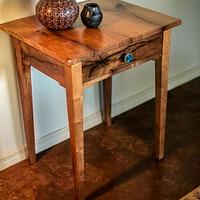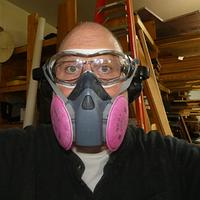Share your craft projects
Make new craft buddies
Ask craft questions
Blog your craft journey

Rich
1285 posts
and
27 followers
in about 3 years
in about 3 years
Adjusting the Incra IBOX in one pass - a foolproof method
Here's the other most popular post from over there. Tucson Woodcraft even includes a print out of it with the Incra IBOX units they sell. Originally posted in January of 2019.
---------------------
When I first got the IBOX a couple of years ago, I was extremely frustrated by it. It's a beautifully engineered tool, but getting it set up was a nightmare. Their KISS calibration and setting the guide fingers to fit the kerf from the test cut was difficult to perfect because too much of it was subjective. You turn the red knob until the fingers come together… but how tight?. After making the test cut you open out the guide fingers to fit the kerf… but how tight? There was enough variance from one setup to another to mean that the first test cut was likely way off. Then, when it was, how much did the silver wheel need to be turned to get it right? I found myself making sometimes a half-dozen test cuts just to get close. Worst of all, some of those test cuts were actually poorer fitting than the previous one. In other words, I wasn't even assured of getting closer with each try.
Well, once I wrapped my head around the jig and realized that there was only one factor that mattered-getting the fingers to fit the kerf-it became easy. Fortunately the IBOX is a well engineered and manufactured product that is capable of being set up for perfect finger joints in just one pass.
Note that this entry shows the process using a router bit. The steps would be identical on the table saw. I just prefer the router but you can use whichever you like.
Follow along and you'll be loving your IBOX again.
For starters, I like to use an adhesive backed strip of 220 grit paper on the fence. It keeps the board from slipping which can ruin an entire project. Note that it only extends down to within about 1/2" of the bottom to avoid dulling the bit.
---------------------
When I first got the IBOX a couple of years ago, I was extremely frustrated by it. It's a beautifully engineered tool, but getting it set up was a nightmare. Their KISS calibration and setting the guide fingers to fit the kerf from the test cut was difficult to perfect because too much of it was subjective. You turn the red knob until the fingers come together… but how tight?. After making the test cut you open out the guide fingers to fit the kerf… but how tight? There was enough variance from one setup to another to mean that the first test cut was likely way off. Then, when it was, how much did the silver wheel need to be turned to get it right? I found myself making sometimes a half-dozen test cuts just to get close. Worst of all, some of those test cuts were actually poorer fitting than the previous one. In other words, I wasn't even assured of getting closer with each try.
Well, once I wrapped my head around the jig and realized that there was only one factor that mattered-getting the fingers to fit the kerf-it became easy. Fortunately the IBOX is a well engineered and manufactured product that is capable of being set up for perfect finger joints in just one pass.
Note that this entry shows the process using a router bit. The steps would be identical on the table saw. I just prefer the router but you can use whichever you like.
Follow along and you'll be loving your IBOX again.
For starters, I like to use an adhesive backed strip of 220 grit paper on the fence. It keeps the board from slipping which can ruin an entire project. Note that it only extends down to within about 1/2" of the bottom to avoid dulling the bit.

Start with the standard instructions from Incra. First, center the allen head screw in the red knob's window using the silver wheel.

Next do the standard KISS procedure. Bring the guide fingers together using the red knob. Don't worry about how tight, just get them close or touching.

Back off at least 1/8" before making your first kerf cut using the red knob.

Continue to follow the Incra directions for getting the guide fingers set to fit the kerf width. It's a bit subjective, but the important thing is that the fit is firm. I like to set them so the kerf will just fit over the guide fingers and requires some pressure to seat it. That way I know it's going to hold steady. Be sure to tighten the locking knob each time you adjust it so it's locked firm, otherwise the adjustment will be off when you do lock it.
Now, here's where my process differs from theirs. Rather than assume the system has done its job and gotten everything set properly, I like to make a second cut and measure the size of the resulting finger. I also measure the width of the kerf rather than trust it exactly matches the size of the cutter. This accounts for variables like runout.


Note that the finger is 0.030" smaller than the kerf. You can adjust for this using the silver wheel. Clockwise increases the size of the finger and counterclockwise decreases it. Since the notches on the silver wheel represent approximately 0.0015" of adjustment for the finger size, you want to turn the silver wheel clockwise by 20 notches, or about 1 1/4 turn (there are 16 notches on the wheel). While that will get you a perfect fit, I find it's one that's a bit too tight for my liking, so I like to allow for about 0.004 to 0.006" slack and therefore will turn the wheel one revolution (16 notches times 0.0015" per notch equals approximately 0.024" increase in the finger size).
Now, trim off those test cuts and make a full set of cuts on the fresh edge. Then cut off the end leaving maybe 1/2" of solid wood holding the fingers. This is my trick for doing test cuts using just one board. It's much easier than prepping two of them.


Use the cutoff piece just as you would normally to align the board for the second set of cuts.

And here you have a perfectly fitting set of finger joints. If you want to tweak the tightness and make another test cut, you can, but the beauty is that what you have now is exact, and your only adjustments will be to turn the silver wheel a notch or two clockwise to tighten, or counterclockwise to loosen the joint. And it only took you one test cut to get there.


Half of what we read or hear about finishing is right. We just don’t know which half! — Bob Flexner
10 Comments
I’m really glad you migrated this one Rich. I refer to it every time I get that jig out!
Thanks, Kenny. That's always been my goal—to share what I can. I'm a numbers guy.
Half of what we read or hear about finishing is right. We just don’t know which half! — Bob Flexner
That’s great Rich! Thank you. That jig works well for me, but it’s usually not so perfect and that keeps me from using it more, this will help! I appreciate the detailed info.
Ryan/// ~sigh~ I blew up another bowl. Moke told me "I made the inside bigger than the outside".
Rich, yes thanks!
Petey
Thanks for all this. I need to pull mine out and try again (lot of frustration on getting it setup).
Is there a way to "save" this in my list?
Is there a way to "save" this in my list?
Thanks everyone. I appreciate the feedback.
Half of what we read or hear about finishing is right. We just don’t know which half! — Bob Flexner
ill try it out Saturday Thanks Rich 🤪
*TONY ** Denver * ALWAYS REMEMBER TO HAVE FUN
BB1, I just bookmarked Rich’s post in my browser.
A good migration of info, thanks Rich
I believe I had a good run of luck with my Ibox. I never had a hitch setting it up, or making changes to the set up. Until I did. After having done it without a hitch so many times before, you can't believe the amount of frustration it caused me NOT to be able to close the gaps. This Tute helped me a lot.
I believe I had a good run of luck with my Ibox. I never had a hitch setting it up, or making changes to the set up. Until I did. After having done it without a hitch so many times before, you can't believe the amount of frustration it caused me NOT to be able to close the gaps. This Tute helped me a lot.
Thanks for all this. I need to pull mine out and try again (lot of frustration on getting it setup).
Is there a way to "save" this in my list?
Barb, or perhaps anyone. If you use the Opera Browser (free download) Anyhow I use Opera for just general surfing. If I happen on a page I really like, all I need to do is right click somewhere on the page, and the drop down you get has the option to save it as a PDF file, pictures and all. That way you can swap the file to any computer you are using via a thumb drive, or print it out and have it hard copy so you don't need a computer in the shop to review it. I've never done it, but I suppose you could email it to yourself to use at a different computer too. This particular file was 4.34Mb in size, not sure how big you can email?
Opera says they are secure, but Banks and a lot of "secure" websites don't play well with it, so I keep it on my desktop to grab to go general surfing with, but never keep it as my default browser, nor so I go to banks with it. But I'm different, and I have a separate computer, kept off network that I bank with anyhow. Worked too hard for it, to let some slimeball walk off with it.
Is there a way to "save" this in my list?
Barb, or perhaps anyone. If you use the Opera Browser (free download) Anyhow I use Opera for just general surfing. If I happen on a page I really like, all I need to do is right click somewhere on the page, and the drop down you get has the option to save it as a PDF file, pictures and all. That way you can swap the file to any computer you are using via a thumb drive, or print it out and have it hard copy so you don't need a computer in the shop to review it. I've never done it, but I suppose you could email it to yourself to use at a different computer too. This particular file was 4.34Mb in size, not sure how big you can email?
Opera says they are secure, but Banks and a lot of "secure" websites don't play well with it, so I keep it on my desktop to grab to go general surfing with, but never keep it as my default browser, nor so I go to banks with it. But I'm different, and I have a separate computer, kept off network that I bank with anyhow. Worked too hard for it, to let some slimeball walk off with it.













